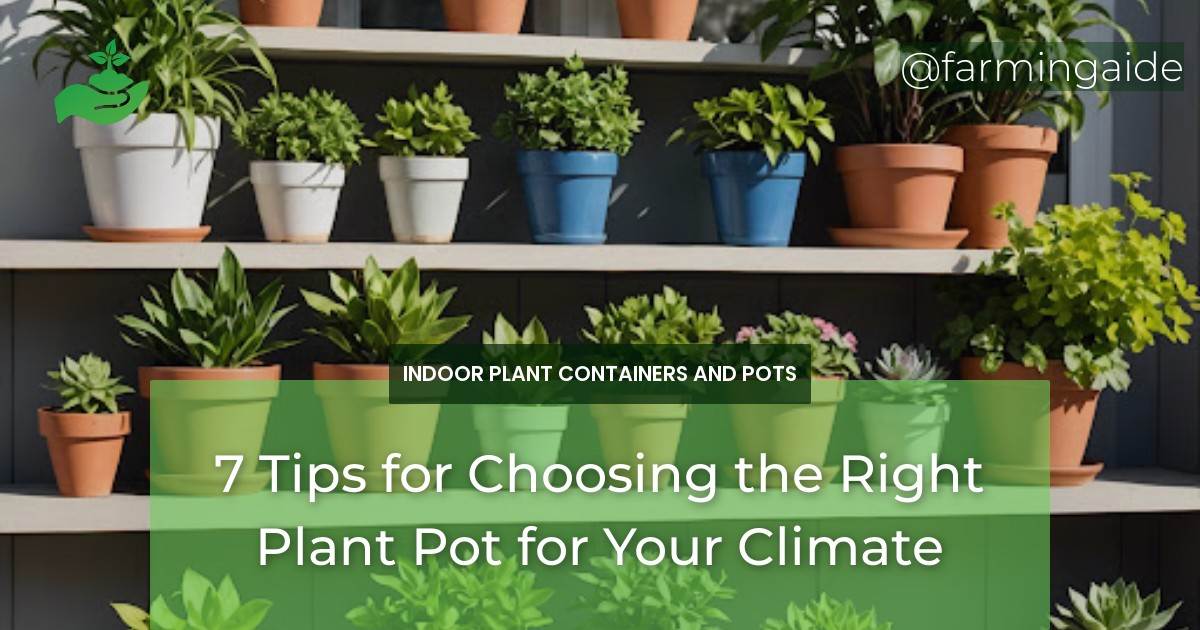When it comes to gardening, choosing the right plant pot is crucial for the health and survival of your plants. With so many options available, it can be overwhelming to select the perfect pot for your climate. In this article, we’ll explore the key factors to consider when choosing a climate-appropriate plant pot, from understanding your climate zone to selecting the right material, size, and color. By the end of this article, you’ll be equipped with the knowledge to make informed decisions and create a thriving garden that adapts to the changing seasons.
Key Takeaways
- Understanding your climate zone is crucial for selecting the right plant pot.
- Different pot materials have unique benefits for various climates.
- Pot size and drainage are essential for plant health.
- Pot color can affect soil temperature and plant growth.
- Seasonal adjustments can ensure the longevity of your plants.
- Eco-friendly pot options are available for sustainable gardening.
Understanding Your Climate
Before selecting a plant pot, it’s essential to understand your climate zone. The USDA Plant Hardiness Zone Map divides North America into 11 zones based on average annual extreme minimum temperatures. Identifying your climate zone will help you determine the best pot material, size, and features for your plants.
Identifying Your Climate Zone
To determine your climate zone, you can use the USDA’s interactive map or consult with local nurseries or gardening experts. Knowing your climate zone will help you choose plants and pots that thrive in your region.
Key Climate Factors Affecting Plant Growth
Temperature, humidity, sunlight, and precipitation are key climate factors that affect plant growth. For example, plants in hot and dry climates require more frequent watering, while plants in cool and humid climates may need better drainage. Considering these factors will help you select a pot that meets the unique needs of your plants.
Material Matters: Choosing the Right Pot Material
The material of your plant pot can significantly impact plant growth. Different materials have unique benefits for various climates and plants. Here are some popular pot materials and their advantages:
ALSO READ
Advantages of Ceramic Pots in Dry Climates
Ceramic pots are ideal for dry climates because they retain moisture and reduce evaporation. They also provide better insulation, keeping soil temperatures cooler in hot climates.
Benefits of Plastic Pots in Humid Environments
Plastic pots are suitable for humid climates because they allow for better drainage and aeration. This helps prevent waterlogged soil and root rot in plants.
Size and Drainage: Essential for Plant Health
Selecting the right pot size and ensuring proper drainage are crucial for plant health. Here’s why:
ALSO READ
Selecting the Appropriate Pot Size
Choose a pot that is large enough to accommodate your plant’s root system. A pot that is too small can lead to root bound, while a pot that is too large can cause the soil to become too wet.
Importance of Proper Drainage in Pots
Good drainage is essential to prevent waterlogged soil and root rot. Look for pots with built-in drainage holes or add a layer of perlite or vermiculite to improve drainage.
Color Considerations: Reflecting or Absorbing Heat
The color of your plant pot can affect soil temperature and plant growth. Here’s how:
Light-Colored Pots for Hot Climates
Light-colored pots can reflect heat and keep soil temperatures cooler in hot climates. This helps prevent overheating and reduces the need for frequent watering.
Dark-Colored Pots for Cold Climates
Dark-colored pots can absorb heat and keep soil temperatures warmer in cold climates. This helps extend the growing season and improves plant growth.
Seasonal Adjustments: Adapting Your Pots to Changing Weather
As the seasons change, your plants’ needs change too. Here’s how to adapt your pots:
Winterizing Your Plant Pots
In colder climates, bring pots indoors or move them to a protected area to protect plants from frost. Add a layer of mulch or straw to insulate the soil and prevent freezing.
Summer Strategies for Pot Placement
In hot climates, place pots in shaded areas or provide shade cloth to prevent overheating. Group pots together to create a microclimate and reduce evaporation.
Eco-Friendly Options: Sustainable Plant Pot Choices
As gardeners, we can reduce our environmental impact by choosing eco-friendly pot options. Here are some sustainable choices:
Biodegradable Pots for Eco-Conscious Gardeners
Biodegradable pots made from natural materials like coconut coir or bamboo are a sustainable alternative to traditional plastic pots.
Recycled Materials in Pot Construction
Look for pots made from recycled materials like recycled plastic or repurposed ceramic. These options reduce waste and minimize the carbon footprint of your garden.
Conclusion: Integrating Pots into Your Climate-Conscious Gardening
In conclusion, choosing the right plant pot is a critical component of climate-conscious gardening. By understanding your climate zone, selecting the right pot material, size, and color, and making seasonal adjustments, you can create a thriving garden that adapts to the changing seasons. Remember to consider eco-friendly pot options to reduce your environmental impact. With these tips, you’ll be well on your way to creating a beautiful and sustainable garden that flourishes in any climate.
Summary of Key Points
Remember to:
- Understand your climate zone and its impact on plant growth.
- Select a pot material that suits your climate and plant needs.
- Choose a pot size that accommodates your plant’s root system.
- Ensure proper drainage to prevent waterlogged soil.
- Consider the color of your pot and its impact on soil temperature.
- Make seasonal adjustments to protect your plants from extreme temperatures.
- Explore eco-friendly pot options for sustainable gardening.
Final Tips for Climate-Appropriate Pot Selection
By following these tips, you’ll be able to select a plant pot that meets the unique needs of your plants and climate. Happy gardening!


